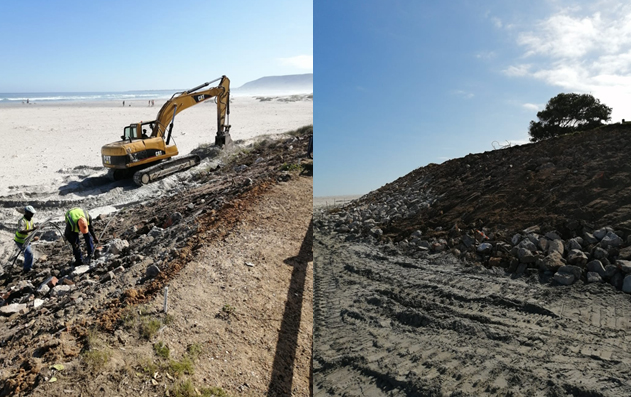Work on the rehabilitation to the slope near the braai area at Grotto East parking area has begun and will be completed by end of May if all goes according to plan.
The rehabilitation consists of repairing the damage done to the elevated parking area, that occurred during a storm in August 2012.
The repair and protection work of the eroded parking area could only commence after receiving the necessary authorisation.
This project has nothing to do with the parking area or the braai area at Grotto East. Should residents have any recommendations or ideas regarding the existing braai facilities and parking area, they can do so via the ward committee. That will be a project on its own and will not form part of this project.
Background:
Due to the unique characteristics of dune formation, the natural outlet for the Klein River estuary was blocked by the dunes that formed after vehicle access was banned some years ago. When the Klein River estuary filled with water from the upstream catchment, it took a different path of least resistance to breach and the outlet then flowed past the Grotto Bay east parking area. This breach coincided with an extreme offshore storm and spring tide. As a result of these conditions and the position of mouth breaching right against the man-made parking lot embankment, scour conditions caused a partial collapse of the seamost bank. This situation was exacerbated during the winter season of 2013, to the extent that the dunes have been cut back to within 6 meters of the tarred road.
This is how it will work:
The area that requires rehabilitation is a 160 metre long curve. The project entails shaping the face of the parking area on the seaward side to a slope of 1:2 vertical to horizontal from the top of the parking lot surface.
The cement rubble mix and large concrete blocks with reinforced material that was used long ago when the parking area was created, will be left in place to help prevent further erosion of the embankment.
Landscaping:
The slope at the parking area will be smoothed over with compacted clay and soil after which it will be planted with appropriate indigenous vegetation, natural to the coastal area.
Although this is a temporary measure until such time as high sea conditions or migration of the estuary mouth to the west again causes erosion and/or further under-cutting of the bottom layers, this option is preferred as it is not a hard engineering option, is quick to implement and not dangerous to the public.

Charel Bruwer of EnviroAfrica (Overberg) Environmental Planning and Impact Assessment Consultants was appointed as Environmental Control Officer to oversee the implementation of the environmental management plan (EMP). Contact him on 082 805 0190 between 07:30 – 18:00 with concerns, queries and complaints regarding the rehabilitation project.

